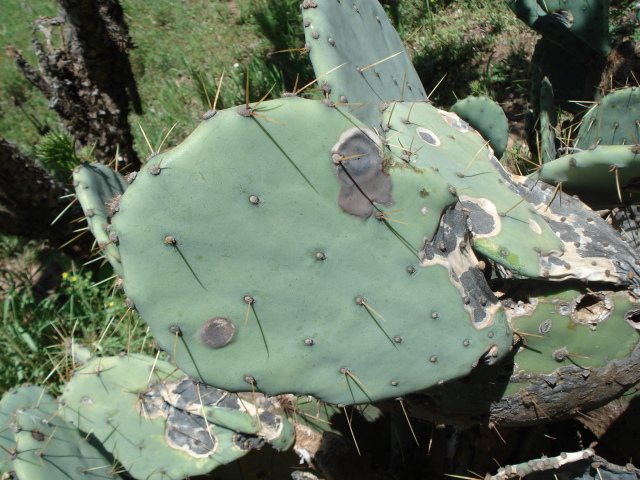Question black spot cactus
black spot cactus
QUESTION: There are these huge spots on my cactus. I have been cutting these leaves off because I thought they were diseased. This has been happening for the last five years. What is it? Too much rain? or is it a bug? Is there a safe spray that I can use because I don't want to poison any animals or us since I do harvest the young tender leave to eat.
ANSWER: Where do you live? What type soil? What are the plants around it like?
---------- FOLLOW-UP ----------
QUESTION: I live in the northwestern part of Texas. My soil only likes plants that likes dry desert conditions. There is another cactus plant beside it. It is a different kind of cactus. It is in good condition. That cactus picture I sent you is a very very old plant, maybe around 30+ years old. Every year I have to cut it back because it grows so large. In this area we have had an unusual amount of rain so early in the year. It looks like it wants to die on me. I think if it survives this year, I am going to cut a good leaf and take out the old plant and replace it with the good leaf. What do you think?
AnswerDear Gloria,
I does look like a fungal infection which is an unusual primary rot in cacti other than Epiphytes. Since the plant has had this problem for five years, I believe that whatever let a fungus or bacteria enter it, it's now in the tissues. The heavy rains may have escalated the problem and if there is rot around the base that it is likely that the roots are rotting. It is an unusual presentation with the spots and that's why I think it's now in the tissue itself growing out. The base does look black to me and that's why I believe it's in the base. The original possibilities are mealybugs that lay eggs in the roots and are very difficult to eradicate and cause rot; cochineal insects which are common to Opuntias - this doesn't look like that - and they usually don't kill the plant; and either some physical or animal insult that broke the tissue and left it open to disease.
It speaks to the strength of this old plant that it's survived this long. I agree with you tho, especially looking at the base, it does look like it's dying. I would take some pads, more than just one, and take them now( make sure you don't see any rot), let them callous and plant them somewhere else now.This is the plant's active growth period. Don't compost the old plant or any of the soil around it. I'd let that soil lie fallow for a season or two to let whatever disease might be left die out.
There is a chance that if the disease is in the tissue it may turn up in the new pads, but it does look like it's mostly at the base and old pads.
I was in Texas once and had sauteed Prickly Pear. How do you cook it?
I'm sure you'll have good luck with the new pads. if you have any more concerns let me know, and if you get a chance, let me know bout those recipes. I have a cold hardy Opuntia and it also grows like crazy. Maybe I could cook some of the pads I cut off.
I'm sure you'll have good luck with your new pads.
Maureen






